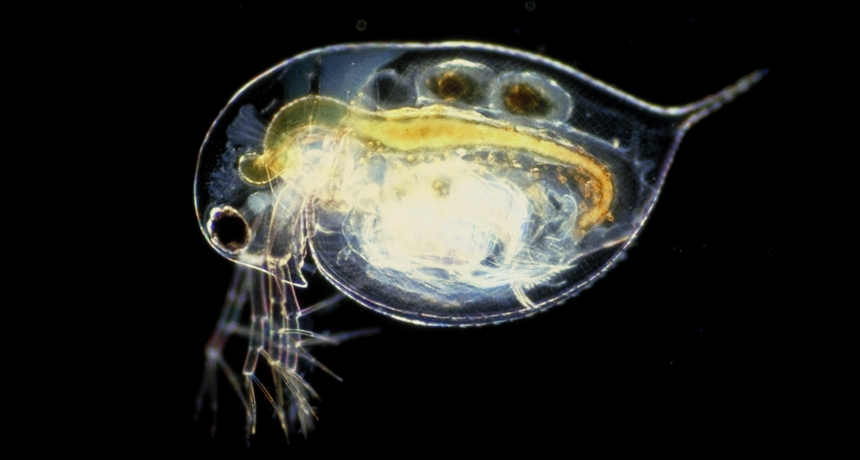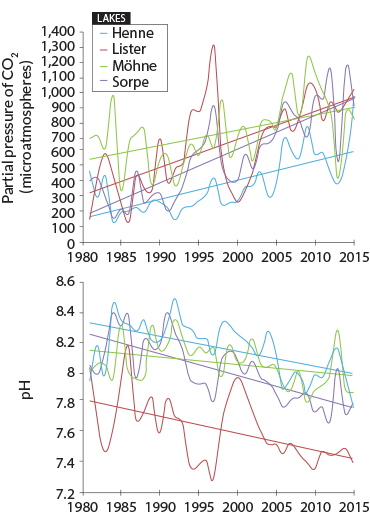Rising CO2 in lakes could keep water fleas from raising their spiky defenses
The greenhouse gas could alter the delicate balance of many lake food webs

SPIKES OUT Tiny lake dwellers known as water fleas (Daphnia pulex shown) raise spiky defenses when sensing predators nearby. But high levels of carbon dioxide in lake waters may dull their senses, leaving the critters open to attack.
Paul Hebert (CC BY 2.5)
Rising carbon dioxide levels could leave some tiny lake dwellers defenseless. Like the oceans, some lakes are experiencing increasing levels of the greenhouse gas, a new study shows. And too much CO2 in the water may leave water fleas, an important part of many lake food webs, too sleepy to fend off predators.
Detailed observations of lake chemistry over long periods of time are rare. But researchers found data from 1981 to 2015 on four reservoirs in Germany, allowing the scientists to calculate how much CO2 levels had risen and how much pH levels, measuring acidity in the water, had dropped, the scientists report online January 11 in Current Biology.
Rising CO2 in Earth’s atmosphere has also increased levels of the gas dissolved in the oceans, making them more acidic (SN: 5/27/17, p. 11). Studies show that ocean acidification alters the behaviors of marine species (SN Online: 2/2/17). It’s less clear how rising atmospheric CO2 levels are affecting freshwater bodies, or how their denizens are coping with change, says aquatic ecologist Linda Weiss of Ruhr University Bochum in Germany.
Comparing the data from the four reservoirs showed that, in those 35 years, the average CO2 level across all lakes rose by about 560 microatmospheres, a unit of pressure. Two of the water bodies experienced a roughly fourfold increase in CO2 levels. For pH, the overall average value dropped from 8.13 to 7.82.
In the lab, the team examined the effect that high CO2 had on the behavior of two species of water fleas, or pinhead-sized lake dwellers also known as Daphnia. The miniature crustaceans are at the bottom of many freshwater food webs. When predators such as the larvae of phantom midges feed on Daphnia, the predators release a chemical signal that cues various species of water fleas to arm themselves with an array of defenses. Some raise forbidding neck spikes; others grow giant “helmets” that make the critters tougher to swallow.
But the water fleas’ sense of danger seemed to be dulled in waters with high CO2 levels. The team tested the critters in waters containing both chemical predator cues and CO2 at partial pressures of 2,000, 11,000 and 16,000 microatmospheres. Although 2,000 microatmospheres is considered high, it is now common enough in lakes that the team used it as the control case. Both species were less defensive at 11,000 and 16,000 microatmospheres (considered worst-case scenario values for many lakes) — displaying fewer neck spikes or developing smaller crests.
Further tests revealed that the elevated CO2 was responsible, rather than the reduced pH. Although it’s unclear exactly how the elevated carbon dioxide leads Daphnia to lower its defenses, the researchers suggest the CO2 acts as a narcotic and blunts the senses.
The variability between lakes in terms of setting and chemistry makes it difficult to draw firm conclusions from the findings, Weiss says. Many lakes are warming (SN: 5/13/17, p. 18). And many are already saturated in carbon dioxide and expelling it into the atmosphere. Others are absorbing it and becoming more acidic.
It is also unclear how other freshwater species, including predators, might be affected at different CO2 levels and in different environments, says Caleb Hasler, an organismal biologist at the University of Winnipeg in Canada, who was not involved in the study. “There’s been a bit of work done on phytoplankton, some on zooplankton, freshwater fishes and mussels. If anything, the effect seems to be highly variable.”
But studies such as this that show long-term trends in CO2 levels are an important part of solving the puzzle, Hasler says. And “showing that there is an impact on an important species is pretty significant.”







